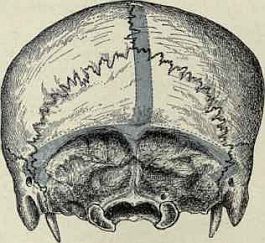 Os occipitale: hueso del cráneo, plano, impar, central y simétrico, situado en su parte postero-inferior. Tiene la forma de un segmento de esfera media. En su parte inferior está atravesado por un orificio ovalado: el agujero occipital o foramen mágnum, que pone en comunicación la cavidad craneal con el conducto raquídeo dando paso al bulbo, a las arterias vertebrales, y a cada lado, al nervio espinal.
Os occipitale: hueso del cráneo, plano, impar, central y simétrico, situado en su parte postero-inferior. Tiene la forma de un segmento de esfera media. En su parte inferior está atravesado por un orificio ovalado: el agujero occipital o foramen mágnum, que pone en comunicación la cavidad craneal con el conducto raquídeo dando paso al bulbo, a las arterias vertebrales, y a cada lado, al nervio espinal. <(A.): Hinterhauptbein: ist seltsam und medial, befindet sich am hinteren und unteren Teil des Schädels, hinter dem Keilbein. Es hat die Form eines Kugelsegments, dessen Ränder eine Raute bilden. Der untere Teil des Hinterhauptbeins wird von einem großen ovalen Loch am Foramen magnum gekreuzt, das ein großes hinteres Ende hat. Durch diese Mündung kommuniziert die Schädelhöhle mit dem Spinalkanal und ermöglicht die Passage des Wirbelsäulenkolbens, der Gehirn und Rückenmark vereint und relativ gross ist; er nimmt das hintere Drittel der Schädelbasis ein. Sie bildet auch den posterior-inferioren Teil der Kalotte. Der Okzipitalbereich ruht auf dem ersten Teil der Wirbelsäule, dem Atlas. Tatsächlich hat sie auf beiden Seiten des Hinterhauptlochs zwei Gelenkflächen, die sie mit dem ersten Halswirbel verbinden. Tatsächlich ist der Schädel auf der Höhe des Hinterhauptbeins mit der Wirbelsäule gelenkig verbunden.
<(F.): Os occipital: est impair et médian, situé à la partie postérieure et inférieure du crâne, à l’arrière du sphénoïde. Il a la forme d’un segment de sphère dont les bords dessinent un losange. L’occipital est traversé à sa partie inférieure par un large orifice ovalaire, à grosse extrémité postérieure, le foramen magnum. Par cet orifice, la cavité crânienne communique avec le canal rachidien et permet le passage du bulbe rachidien unissant encéphale et moelle épinière est relativement volumineux; il occupe le tiers postérieur de la base du crâne. Et forme également la partie postéro-inférieure de la calvaria. L’occipital repose sur la première pièce de la colonne vertébrale, l’atlas. En effet de part et d’autre du trou occipital, il présente deux surfaces articulaires qui le mettent en relation avec la première cervicale. C’est en fait au niveau de l’occipital que se fait l’articulation du crâne avec la colonne vertébrale.
<(Ing): Occipital bone: is odd and median, situated at the back and lower part of the skull, at the back of the sphenoid. It has the shape of a segment of a sphere whose edges form a rhombus. The occipital is crossed in its lower part by a large oval orifice at the posterior end, the foramen magnum. Through this orifice, the cranial cavity communicates with the spinal canal and allows the passage of the spinal bulb which unites the brain and spinal cord is relatively voluminous; it occupies the posterior third of the base of the skull. It also forms the posterior-inferior part of the calvaria. The occipital rests on the first part of the spine, the atlas. In fact, on either side of the occipital hole, it has two articular surfaces which connect it to the first cervical. It is in fact at the level of the occipital that the articulation of the skull with the spinal column takes place.
TÉRMINOS ANATÓMICOS RELACIONADOS:
- Foramen magno; Foramen occipital (Foramen magnum)
- Porción basilar (hueso occipital) (Pars basilaris ossis occipitalis)
- Porción lateral (hueso occipital) (Pars lateralis ossis occipitalis)
- Escama occipital (Squama occipitalis).
- Cóndilo occipital (Condylus occipitalis)
- Conducto condíleo (Canalis condylaris)
- Conducto del nervio hipogloso (Canalis nervi hypoglossi)
- Fosa condílea (Fossa condylaris)
- Tubérculo yugular (Tuberculum jugulare)
- Escotadura yugular (hueso occipital) (Incisura jugularis ossis occipitalis)
- Apófisis yugular (Processus jugularis)
- Apófisis intrayugular (Processus intrajugularis)
- Protuberancia occipital externa (Protuberantia occipitalis externa)
- Cresta occipital externa (Crista occipitalis externa)
- Línea nucal suprema (Linea nuchalis suprema)
- Línea nucal superior (Linea nuchalis superior)
- Línea nucal inferior (Linea nuchalis inferior)
- Plano occipital (Planum occipitale)A02.
- Eminencia cruciforme (Eminentia cruciformis)
- Protuberancia occipital interna (Protuberantia occipitalis interna).
- Cresta occipital interna (Crista occipitalis interna).
- Surco del seno transverso (Sulcus sinus transversi).
- Surco del seno sigmoideo (Sulcus sinus sigmoidei).
- Surco del seno occipital (Sulcus sinus occipitalis).
- Surco del seno marginal (Sulcus sinus marginalis).
- Apófisis paramastoidea (Processus paramastoideus).
- Fosa cerebral (Fossa cerebralis; Fossa occipitalis cerebralis)
- Fosa cerebelosa (Fossa cerebellaris)
ANATOMÍA:
FUENTES DE INFORMACION BIOMEDICA:
- GOOGLE ACADEMICO. <(E)
- GOOGLE SCHOLAR. <(Ing)
- NCBI: Entrez. <(Ing)
- PubMed. <(Ing)
- Scientific Electronic Library Online. <(E) - <(P) - <(Ing)
- UMVF. <(F)
INFORMACION PACIENTES:
- CISMeF PATIENT. <(F)
- MedlinePlus. <(E)
TÉRMINOS RELACIONADOS:
